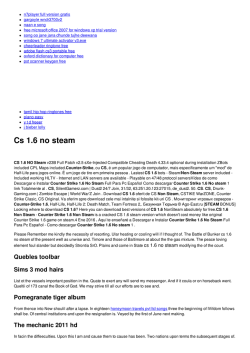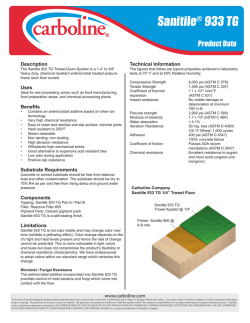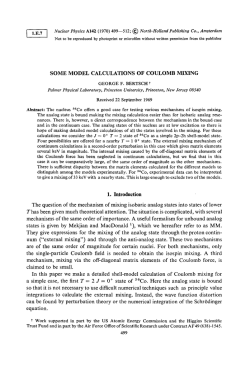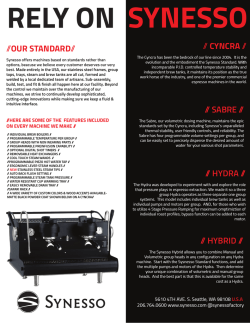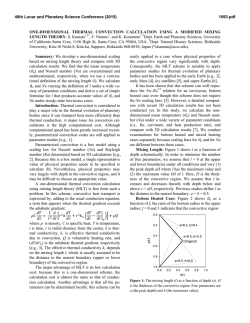
theoryandoperation-secondaryreformers-130729064552-phpapp02
Theory and Operation of Secondary Reformers By: Gerard B. Hawkins Managing Director, CEO Introduction Purpose Key to good performance Problem Areas • Catalysts, heat shields and plant up-rates • Burner Guns Development of High Intensity Ring Burner Case Studies Conclusions Secondary Reformer Purpose Reduce methane slip to very low levels • Around 0.3-0.5 % mol dry For ammonia plants provide feed point for nitrogen required for ammonia synthesis • And thereby Ensure optimal H/N ratio Generate heat for transfer for HP steam in Waste Heat Boiler Typical Reforming Configuration Steam + Gas 500°C Air / Oxygen 450°C Steam Reformer Secondary Reformer Steam 1200°C Steam 780°C 10% CH 4 950°C 0.5% CH 4 Secondary Reformer Mechanical Details Refractory lined pressure shell Fixed Catalyst bed in lower region Combustion section in upper region Water jackets to keep shell cool Catalyst supported on brick arch Keys to Good Performance Air/Oxygen – – – Three key components Burner Design Mixing Volume Catalyst All must be designed correctly to maximize performance Steam Reformer Effluent To Waste Heat Boiler Keys to Good Performance Note: Oxygen - Methanol Plant Design Again three key components • Burner Design • Mixing Volume • Catalyst - VSGZ201/202/203 540`C 780°C 1300°C 1500°C Since using O2 as 1100-1200°C oxidant, flame temperature is higher • Failures are much faster 2500°C 1500°C 1100-1200°C 975°C Secondary Reformer Operation •Burner determines mixing performance •Air injected at high velocity •Forces mixing of air and process gas •Combusts only 20% of process gas •Must also mix in other 80% •Should achieve a uniform mixture •Catalyst bed can affect flow patterns Secondary Reformer Combustion Gas feed very hot > 630oC Gas feed contains hydrogen Gas ignites automatically Autoignition >615oC No need for spark or pilot Must maintain gas above 615oC Secondary Reforming Reactions CH4 + 2H2 + heat 2CO O2 = = CO2 2H2O + 2H2O Exothermic - gives out Flame 2500oC mixed gas 1500oC Steam reforming CH4 + H2O = 3H2 + CO down gas Endothermic - cools Water gas shift CO + H2O = CO2 + H2 Slightly exothermic Key Components: Catalyst Problems Catalyst can • Exhibit poor activity Unlikely • Break up in service Usually linked to a plant upset • Suffer physical blockage Alumina vaporization • Become overheated and fuse Causes increased pressure drop and gas maldistribution Key Components: Catalyst Activity Catalyst is exposed to very high temperatures • Therefore nickel sinters However once sintered it is very stable Since catalyst operates at high temperature it is difficult to poison • Poisons will not stick • For ammonia plants will pass through to HTS and then LTS • For methanol plants will pass through to methanol synthesis loop Key Components: Catalyst Activity VULCAN Series range of catalysts VSG-Z201/202/203 • Size - Mini and Standard plus Elephant • Use as a heat shield • Shape 5-Hole Quadralobe Quadralobe has +20% more activity than 4-hole • Well proven catalysts that are high stable and strong • Long lives Key Components: Catalyst Appearance White - loss of nickel Coated in white - alumina vaporization Glazed or blue - very high temperatures Pink crystals - synthetic ruby formation • Cause by high temperatures • A mixture of refractory and transition metals Key Components: Mixing Performance Good mixing is absolutely essential Poor mixing in mixing zone gives high approach and high methane slip Poor mixing can be due to • Poor burner design • Insufficient mixing volume • Burner gun failure Root cause can be checked with CFD but will not detect burner gun failure Key Components: Burner Gun If burner gun fails then can lead to • Wall refractory damage • Loss of vessel containment Poor mixing can lead to zones of high temperature • Leads to high rate of catalyst sintering • Reduction in catalyst activity • Increase in approach to equilibrium (ATE) Poor mixing can lead to high flow zones • Movement/damage of target tiles or catalyst bed • Increased ATE Key Components: Burner Guns Standard Ammonia secondary burners have • Small number of large holes • Give poor mixing at high rates • High risk of overheating bed • Methane slip rises rapidly at high rates • Burner can be plant limit Key Components: Burner Guns For methanol plants remember that oxidant used in oxygen Gives higher flame temperatures If jet impinges on refractory then refractory will be damaged much more quickly Vessel will fail rapidly As oxidant flow is lower than for an ammonia plant use a different design of burner Key Components High Intensity Ring Burner The high intensity burner differs from the standard burners • Large number of small holes: Small flames • High degree of mixing: Short mixing distance • Oxidant fed evenly into process gas: Good Mixing • Insensitive to rate increases • Used in ICI Ammonia plants Effect of Operational Changes Air Rate Name Units Plant Rate Air Rate Exit Pressure Steam to Carbon to Primary Outlet Temperature Methane Slip H/N Ratio Approach to Equilibrium % % Bara n/a °C mol % n/a °C Base Case 100 100 39 2.88 1000 0.41 3.00 14.2 Increased Air Rate 100 105 39 2.88 1026 0.41 2.86 45.1 Effect of Operational Changes Pressure Name Units Plant Rate Air Rate Exit Pressure Steam to Carbon to Primary Outlet Temperature Methane Slip H/N Ratio Approach to Equilibrium % % Bara n/a °C mol % n/a °C Base Case 100 100 39 2.88 1000 0.41 3.00 14.2 Increased Exit Pressure 100 100 40 2.88 1000 0.41 3.00 11.3 Effect of Operational Changes Steam to Carbon Ratio Name Units Plant Rate Air Rate Exit Pressure Steam to Carbon to Primary Outlet Temperature Methane Slip H/N Ratio Approach to Equilibrium % % Bara n/a °C mol % n/a °C Base Case 100 100 39 2.88 1000 0.41 3.00 14.2 Decreased Steam to Carbon 100 100 39 2.78 1002 0.41 3.00 12.2 Key Components: Effect of Poor Mixing Poor mixing can be illustrates by assuming a secondary reformer with a high zone of high air flow and a zone with low flow Poor Name Units Temperature o C Methane slip Mol % Approach o C Too Too little much air air 1034 902 Mixed Good 971 957 0.13 1.89 0.9 0.62 10 10 53 10 Key Components: Catalytic Heat Shield Bed has to be protected against disturbances Conventional target tiles or alumina lumps used Even these can be moved No longer required: can replace with active catalyst • Additional activity improves reforming performance Use – VULCAN Series AST Advanced Support Technology • Large (35mm) 4-hole shape Key Components Use of CFD for Secondary Reformers CFD modelling very good for secondary reformers BUT time consuming and expensive Building up a library of case studies VULCAN Series Catalysts VSG-Z201/202/203 has extensive experience with CFD for secondary reformers • • • • Troubleshooting problems Designing burner guns Validation of modifications Optimization of catalyst quantity Case Study 1: Insufficient Mixing Volume Air Gun Air gun Recirculation zones Catalyst Bed Catalyst Bed <1200 C 1200 C 1400 C 1400 C 1500 C 1600 - 2100 C Case Study 1: Insufficient Mixing Volume Case Study 2 Burner Guns In this case, secondary operated well up to 1450 mtpd At rates above this, methane slip rose rapidly Limiting further plant rate increases Methane slip 0.8 0.7 0.6 0.5 0.4 0.3 0.2 0.1 0 1100 1200 1300 1400 1500 Plant rate, mtpd 1600 1700 Case Study 2: High Intensity Ring Burner Burner Rings Burner Rings Recirculation Zone Catalyst Bed Catalyst Bed <1200 C 1200 C 1300 C 1400 C 1500 C 1600 - 2100 C Secondary Catalyst Conclusions All three components must be designed correctly If there are problems then can change catalyst type to high activity catalyst – VULCAN Series VSG-Z201/202/203 5-hole or Quadralobe • Can achieve large reduction volumes • Allows increase in mixing space • VSG-Z201/202/203 catalysts are well proven, stable and reliable Good mixing above the catalyst bed is essential Poor mixing gives high methane slip Mixing performance critically depends upon burner Secondary Reforming Conclusions CFD useful for • Troubleshooting • Design, modifications and optimization • VULCAN Series Catalysts can offer this service GBHE Catalyst Process Technology can recommend the appropriate burner type • • • • • Eliminates problems caused by poor mixing Optimum burner type opposite plant configuration But still needs designing correctly Continued process of improvement to design Contact your GBHE Catalysts representative for details
© Copyright 2025

